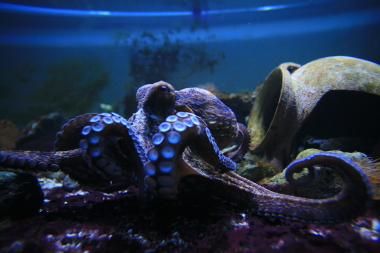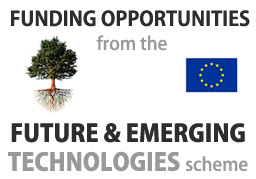OCTOPUS Integrating Project
Novel Design Principles and Technologies for a New Generation of High Dexterity Soft-bodied Robots Inspired by the Morphology and Behaviour of the Octopus
Objectives
OCTOPUS aims at investigating and understanding the principles that
give rise to the octopus sensory-motor capabilities and at
incorporating them in new design approaches and technologies for
building physically embodied, soft-bodied, hyper-redundant, dextrous
artefacts. To this purpose, a robotic artefact will be built in
OCTOPUS, that can locomote in water over a variety of terrains,
explore narrow spaces, grasp objects and manipulate them effectively.
The OCTOPUS IP is
not focused only on the study and imitation of one octopus arm, but
on the study of the whole octopus body
and how its eight arms are coordinated
in manipulation and locomotion tasks.
This is required to embrace the full complexity of investigating the
relations between morphology and
behaviour. The overall complexity of
the proposed research is significantly increased with respect to
previous approaches addressing the development of one arm and
justifies the presence in the consortium of diverse interdisciplinary
expertise and the amount of research and development effort devoted
to this IP.
This IP is expected to achieve new science and new technology,
demonstrated by joint publications and patents, through a truly
interdisciplinary research work programme, by a consortium of
engineering and biology groups, each involving diverse disciplines
and all experienced in biomimetics. As more and more widely
recognized today, both science and engineering can benefit from joint
research in biomimetics: on one hand, biology provides the knowledge
and models on the biological system to take inspiration from for
developing biomimetic systems; on the other hand, the development of
biomimetic systems provides insight into the animals they are
inspired from, and can even represent a powerful tool for
experimental investigation on the living organism itself.
To grow this interdisciplinary community, scientific and educational events will
be purposively organized in the IP, like tutorials, brainstorming
meetings, and schools for students and young researchers.
The new technologies expected to result from the IP concern actuation (soft actuators), sensing (distributed flexible tactile sensors), control and robot architectures (distributed control, coordination of many dof), materials (variable stiffness), mechanisms (soft-bodied hydrostat structures), kinematics models. The final robotic octopus prototype will be capable of locomotion on different substrates, of squeezing into small apertures, of dextrous manipulation by coordinating the eight arms, of anchoring in order to exert forces on external environment; of controlling a flexible structure with virtually infinite DOFs. This IP is expected to achieve new science and new technology, demonstrated by joint publications and patents, through a truly interdisciplinary research work programme, by a consortium of engineering and biology groups, each involving diverse disciplines and all experienced in biomimetics, possessing, as a consortium, the best expertise available in Europe for pursuing the objectives of the IP.
Octopus vulgaris
The octopus is a marine invertebrate with amazing motor capabilities and intelligent behaviour, which are quite impressive with respect to its position in the evolutionary scale (Phylum: Mollusca, Class: Cephalopoda). Most recognized theories explain that these enhanced behaviour and capabilities for interaction with the environment are due to the special morphology of the body, and especially to the high manoeuvrability attributed to the form and materials of the arms and their efficient neural control mechanisms. What is special in the octopus is that his body has no rigid structure. Thanks to this, the octopus can adapt the shape of its body to the environment and its whole body can be squeezed into very small apertures, limited only by the size of its rigid brain capsule. The octopus has eight arms which can twist, change their length, be bent in all directions at any point along the arm and, despite of the lack of rigid skeletal support, can vary their stiffness to achieve relatively high values and to apply relatively high forces. Octopus arms, as tentacles of squids, tongues of lizards and mammals and elephant’s trunk, belong to what are called muscular hydrostat which are composed almost entirely of muscle and lacks totally of skeletal systems. In these structures the musculature has the role both of skeletal support and movement system allowing a rich variety of complex movement with high dexterity and fine control. In a muscular hydrostat structure the musculature is arranged in a closely packed three-dimensional array of muscles, which fibres are oriented in three general direction: perpendicular to the long axis (transverse muscle), parallel to the long axis (longitudinal muscle) and helical or oblique around the long axis (helical or oblique muscles). These structures have the main property of maintaining constant the volume during contraction, with the different bundles that operate with synergic or antagonistic role, so any change in one dimension will cause a compensatory change in at least one other dimension. The control of the large number of degrees of freedom is highly distributed and is simplified by the use of stereotyped movements.
From an engineering point of view, the octopus and its arms present interesting characteristics, such as:
New Design Principles and Technologies
The OCTOPUS IP aims at deep analysis of the tissues and materials properties,
the biomechanics, kinematics and dynamics modelling, and the study of the sensing
system and control systems strategies and of the ways in which these octopus
features affect relationships and interactions with the environment.
The anatomical, neuro-physiological and behavioural characteristics studied on
the whole octopus will be applied to the design and development of the 8-arm robotic
octopus-like artefact.
The distributed control system of OCTOPUS envisages three levels: the central
behavioural architecture; the peripheral highly distributed sensory-motor control
system and the mechanical ("embodied") intelligence.
The overall behaviour is given by the interaction of the three levels and by the
combination of the behaviours that each level controls.
According to the principles of biomechatronic design, the different components
of a system (actuators, sensors, materials) are designed from models of the reference
biological system, in an integrated way.
Expected Results
OCTOPUS can be considered as a basic (scientific and technological) research project with an impact both in engineering and biology fields. New science and new scientific data will result from the focused research on the octopus, as well as from some of the experimental activities during the technological development phases. New technology and new design principles will come out in the form of prototypes, both for components and for an integrated system. The results expected from OCTOPUS will have an impact on academic researchers in engineering and biology and on the future development of ICT and robotics. The final OCTOPUS artefact will be built with no use of rigid structures and show all the capabilities of an octopus. This can be used in exploration and monitoring tasks, for the capability to reach impracticable places, but also in maintenance or rescue tasks, because of the simultaneous manipulation capability.


